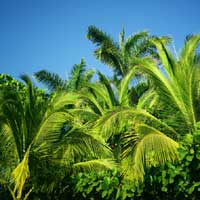
Plantations please big business but threaten the planet’s already over-burdened ecology. Martin Oliver looks at the reality.
In the public’s perception, tropical deforestation tends to be linked to population growth in the developing world, and the expansion of primitive “slash and burn” agriculture. But in recent decades big corporate projects have caused most of the damage, adding oil palm plantations to logging, mining and cattle ranching.
Originating from Guinea in West Africa, the oil palm has spread in a wide swathe across the humid tropics. In many cases, high conservation value rainforest has been destroyed to make way for monoculture plantations, and this trend is accelerating.
The palm oil yield of about 6000 litres per hectare far surpasses its competition among other edible oils. This remarkable productivity is reflected in its cheap price on the world market.
Thumbs down
Global palm oil production is following an exponential growth curve, and in 2005, it overtook soya as the world’s most produced vegetable oil. What once used to be a cheap oil largely used in developing countries has become sought after in the affluent West. An upsurge of awareness about the risks of hydrogenated oils and “trans” fats has encouraged a switch to palm oil as a non-trans fat alternative. But many health experts are not impressed. {quotes}Palm oil is high in saturated fat and has received a thumbs-down from Australia’s Heart Foundation.{/quotes}
By the early 20th century, the oil palm had reached Malaysia and what is today Indonesia. This set the scene for future domination of global production by these two countries, which together account for about 85% of the current market, one that is dominated by huge plantations. The palm oil smallholdings encountered in some other parts of the world are less commonly found in this part of South-East Asia.
Today, Borneo represents the frontline where industrial interests are encountering environment and animal welfare groups that want to see the remaining high conservation value forest preserved.
Straddling the equator, Borneo is the world’s third largest island, and most of its landmass is divided between Indonesian and Malaysian provinces. In the 1980s, the island was discovered by the tropical timber industry, and now about half of the forest cover has disappeared.
Deforestation crisis
The palm oil and logging industries have a close relationship, as it is common practice to first log the rainforest for its valuable timber and then set fire to the remaining vegetation before planting oil palms. Palm oil has been linked to many of the fires in the region, which reached a dramatic peak in the 1997-8 season when haze affected several nearby countries, causing many people to experience health problems.
A study published last year in the journal Conservation Letters found that between 1990 and 2005 somewhere between 55-59% of Malaysian palm oil plantations were established on previously forested land. For Indonesia, the figure was at least 56%.
Greenhouse emissions
Tropical deforestation is responsible for about 20% of the world’s greenhouse emissions, and Indonesia is the world’s third largest emitter of CO2, after China and the US.
As the available supply of lowland forest land for oil palm production becomes scarcer, there is increasing pressure on peat swamp land, and in February the conversion of peatlands was given official approval by Indonesia’s environment minister. Unfortunately, draining peatlands is a major disaster, releasing vast quantities of CO2 into the atmosphere.
Susan Page at the University of Leicester has estimated that {quotes}over a 25-year period one tonne of palm oil from a plantation established on peatland is responsible for between 15 and 70 tonnes of carbon emissions from forest clearance, deliberately lit fires, and peat decomposition.{/quotes}
Against this gloomy backdrop, some hope has been generated by the UN’s new Reducing Emissions from Deforestation and Forest Degradation initiative, more often known as REDD. This cutting-edge field of “avoided deforestation” is seen by many as an important means of checking climate change. There has been recent speculation that if the price of carbon is sufficiently high, the resulting avoided deforestation payments to a country that decides to leave its forests intact could become competitive with the economic returns from palm oil.
Damage list
Palm oil is associated with a range of other environmental issues that include:
Soil erosion. Monoculture plantations typically lack ground cover that holds the soil in place.
Water pollution, usually from mill effluent, but also from peat nutrients.
Loss of biodiversity, as plantations can only support a fraction of the species found in a forest.
Use of toxic herbicides, particularly paraquat, which has been banned in the EU and Switzerland. Every year some workers die from paraquat poisoning.
Social and human rights problems extend to:
Low pay among palm oil workers.
The common use of child labour.
Forcible eviction of some communities to make for palm oil plantations, and the illegal appropriation of land pose risks to the five million indigenous people who make Borneo their home. Some tribes are threatened by palm oil expansion.
Biodiesel option
Currently, much of the biodiesel sold in Australia is an environmentally sound product derived from waste vegetable oil or animal tallow.
However, another cost-effective option for industry is to source biodiesel from imported virgin (as opposed to recycled) palm oil. These economics supported the construction of Australia’s first palm oil biodiesel plant, which opened in Darwin in 2006. Biodiesel consumers may want to double-check the origin of their product.
Helpfully, in 2007 the CSIRO carried out a life cycle analysis of biodiesel, looking at reductions in greenhouse emissions. When derived from used vegetable oil these fell by 87%, if sourced from an existing palm oil plantation the drop was 79%, and if from tallow the figure was 75%. Unfortunately for the consumer, there is no way to tell whether the product comes from an older plantation or one that has been newly developed. When derived from what was formerly rainforest or peatland, the CSIRO calculated the total emissions to be 8 to 21 times higher than regular diesel.
In Malaysia and Indonesia, a few palm oil biodiesel refineries have already been built, and many others are under construction. Much of their output is destined for domestic consumption.
Greenwash accusations
A few years ago, industry bodies in Indonesia and Malaysia began making reassuring environmental claims. But their critics see these as little more than greenwash. When the Malaysian Palm Oil Council promoted the environmental virtues of palm oil on British television, it fell foul of the UK’s Advertising Standards Authority.
The Roundtable on Sustainable Palm Oil (RSPO) was established in 2004 as a multi-stakeholder forum involving growers, commodity traders, food manufacturers, and retailers. Rainforest loss is one of the environmental concerns addressed in its standards. Oil giant Unilever, one of the founder members, has promised that by 2015 all of its palm oil will come from sustainable plantations. So far, about 40% of the industry has joined up.
According to the Palm Oil Action Group, no information has ever come to light about penalties imposed as a result of RSPO members violating its standards, and independent verification of member practices is paramount. These views are echoed by nearly two hundred environment and human rights groups that in 2008 signed a joint International Declaration Against the ‘Greenwashing’ of Palm Oil, specifically targeting the RSPO, and accusing it of being a front to let industry carry on with its operations in a business-as-usual fashion.
Perhaps the toughest challenge facing the RSPO is a lack of commitment among manufacturers. In November 2008, the first shipment of certified sustainable palm oil, totalling 1.3 million tonnes, reached Europe. But its availability alone was not enough of an incentive to make this supply chain initiative a success. A price premium of an extra 8-15% resulted in only 1% of the total being purchased, causing the remainder to be returned.
Boycott question
Most activists and concerned individuals are responding to the problems associated with palm oil by finding alternatives. Some researchers disagree with a blanket boycott approach, claiming that if it was followed en masse, there would be negative effects on the poor communities that grow the oil. But most palm oil now comes from large plantations that do not provide many benefits to nearby communities.
As production is growing exponentially, a boycott on a limited scale is likely to only slow down the rate at which production increases, thereby reducing the number of new plantations being established.
Another future possibility would be to create a credible palm oil certification mark for consumers, similar to the one used by the Forest Stewardship Council for sustainable timber. This would ensure that responsible companies are rewarded, instead of all palm oil being tarred with the same broad brush.
Resources
Palm Oil Action Group
http://www.palmoilaction.org.au
Palm oil-free consumer guide
http://www.tinyurl.com/cwvcxw
Australian Orangutan Project
http://www.orangutan.org.au
Borneo Orangutan Survival Australia
http://www.orangutans.com.au
Roundtable on Sustainable Palm Oil
http://www.rspo.org
Biofuelwatch
http://www.biofuelwatch.org.uk
REDD programme
http://www.undp.org/mdtf/UN-REDD








































